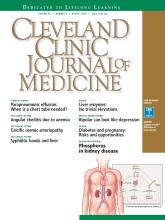Article Figures & Data
Tables
Goals Hemoglobin A1c < 6.5% (if this can be done safely) Fasting plasma glucose < 95 mg/dL (5.3 mmol/L) One-hour postprandial glucose < 140 mg/dL (7.8 mmol/L) Gestational diabetes 1-step approach:
75-g glucose tolerance testing
Fasting plasma glucose ≥ 92 mg/dL (5.1 mmol/L)
1-hour plasma glucose ≥ 180 mg/dL (10.0 mmol/L)
2-hour plasma glucose ≥ 153 mg/dL (8.5 mmol/L)2-step approach:
50-g glucose tolerance testing: a value ≥ 140 mg/dL (7.8 mmol/L) at 1 hour warrants a 3-hour 100-g test. If 2 of the values below are abnormal, the diagnosis is gestational diabetes.
Fasting plasma glucose ≥ 95 mg/dL (5.3 mmol/L)
1-hour plasma glucose ≥ 180 mg/dL (10 mmol/L)
2-hour plasma glucose ≥ 155 mg/dL (8.6 mmol/L)
3-hour plasma glucose ≥ 140 mg/dL (7.8 mmol/L)Hypoglycemia (avoid) Plasma glucose concentration ≤ 70 mg/dL (≤ 3.9 mmol/L) Adapted from information in references 12 and 13.
Medicationsa Pregnancy categoryb Lactation Fetal exposure Insulins Insulin lispro B Safe Unlikely Insulin aspart B Safe Unlikely Insulin glulisine C Probably safe Unlikely Regular B Safe Unlikely Neutral protamine Hagedorn B Safe Unlikely Insulin detemir B Safe Unlikely Insulin glargine C Probably safe Unlikely Oral antiglycemics Metformin B Unsafe, but not contraindicated Crosses placenta Second-generation sulfonylurea: glyburide B Unsafe, but not contraindicated Crosses placenta First-generation sulfonylureas Not recommended Antihypertensives Labetalol C Probably safe Crosses placenta, but acceptable safety profile Nifedipine (long-acting) C Probably safe Crosses placenta, but acceptable safety profile Methyldopa B Probably safe Crosses placenta, but acceptable safety profile Diltiazem C Probably safe Crosses placenta Hydralazine C Probably safe Crosses placenta Angiotensin-converting enzyme inhibitors Not recommended Angiotensin II receptor blockers Not recommended Others Low-dose aspirin Not classified Statins X Folate supplementation A ↵a Other classes of diabetes drugs not listed here, such as thiazolidinediones, alpha glucosidase inhibitors, glucagon-like peptide 1 receptor agonists, and dipeptidyl peptidase 4 inhibitors, have not been studied, and as there are very few data on their effects during pregnancy, should probably be avoided.
↵b Category A: Adequate and well-controlled studies have failed to demonstrate a risk to the fetus in the first trimester of pregnancy (and there is no evidence of risk in later trimesters). Category B: Animal reproduction studies have failed to demonstrate a risk to the fetus and there are no adequate and well-controlled studies in pregnant women. Category C: Animal reproduction studies have shown an adverse effect on the fetus and there are no adequate and well-controlled studies in humans, but potential benefits may warrant use of the drug in pregnant women despite potential risks. Category D: There is positive evidence of human fetal risk based on adverse reaction data from investigational or marketing experience or studies in humans, but potential benefits may warrant use of the drug in pregnant women despite potential risks. Category X: Studies in animals or humans have demonstrated fetal abnormalities and/or there is positive evidence of human fetal risk based on adverse reaction data from investigational or marketing experience, and the risks involved in use of the drug in pregnant women clearly outweigh potential benefits.
Adapted from information in references 9, 16, and 18.






